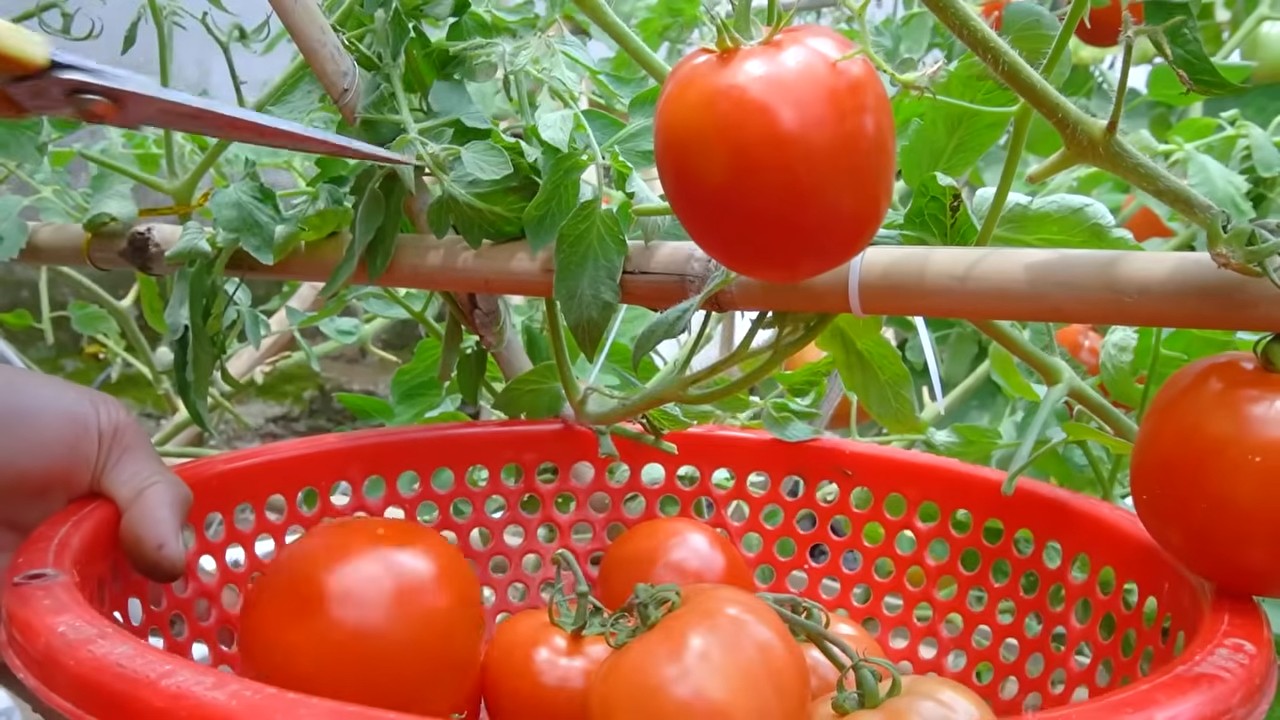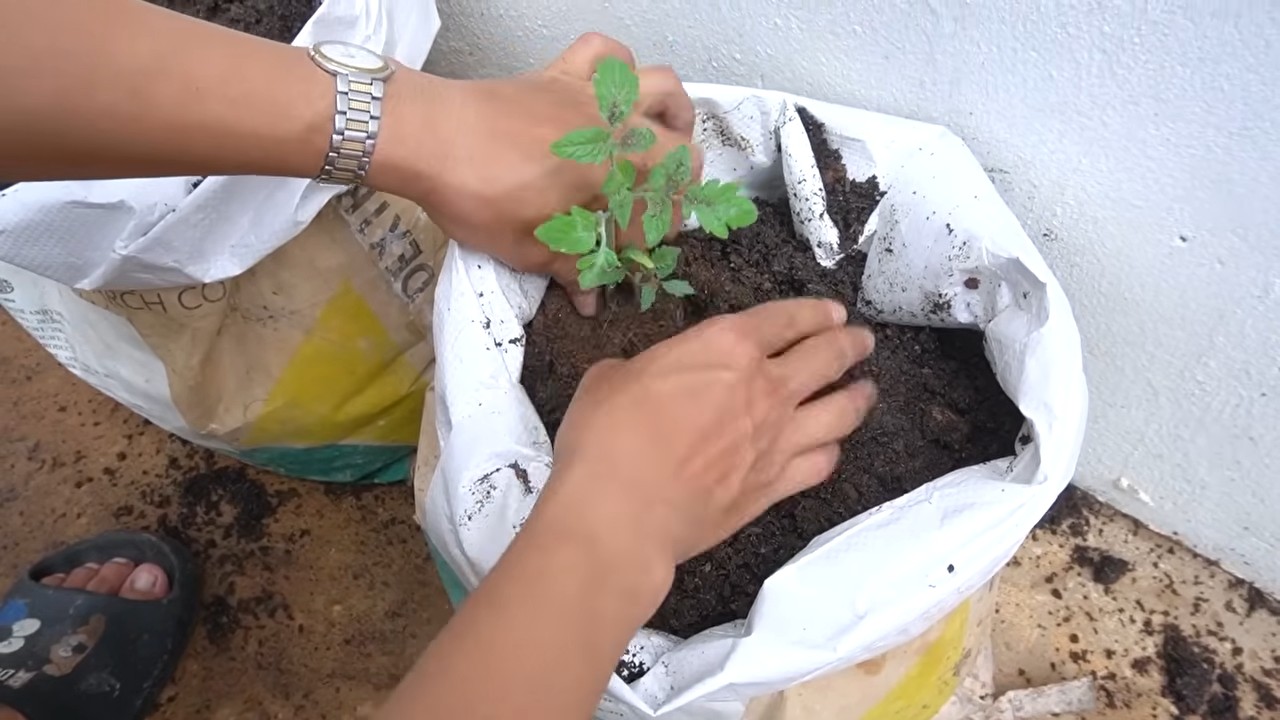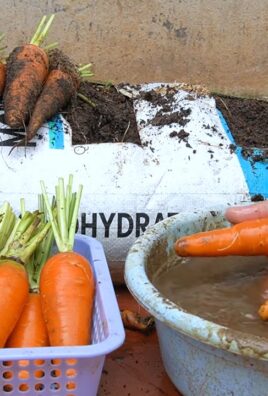Best Tomato Growing Tips are what every gardener, from novice to seasoned pro, craves! Imagine biting into a juicy, sun-ripened tomato, bursting with flavor, that you grew yourself. That’s the dream, right? But sometimes, achieving that perfect tomato harvest feels more like a battle against pests, diseases, and unpredictable weather.
For centuries, tomatoes have been a staple in cuisines around the world, originating in South America and making their way to Europe in the 16th century. Today, they’re a beloved ingredient in everything from salads to sauces. But let’s face it, store-bought tomatoes often lack the vibrant taste of homegrown ones. That’s where these DIY tricks come in!
I’m here to share my tried-and-true secrets to help you cultivate the most delicious and abundant tomato crop you’ve ever seen. Whether you’re struggling with blossom end rot, battling tomato hornworms, or simply want to maximize your yield, these best tomato growing tips will empower you to overcome common challenges and unlock the full potential of your tomato plants. Get ready to transform your garden into a tomato paradise!

Unlocking Tomato Nirvana: My Ultimate DIY Guide to Growing the Juiciest, Most Flavorful Tomatoes Ever!
Okay, tomato lovers, gather ’round! I’m about to spill all my secrets for growing tomatoes that are so good, they’ll make your taste buds sing. Forget those bland, watery grocery store tomatoes. We’re talking about sun-ripened, bursting-with-flavor goodness, straight from your own backyard (or balcony!). This isn’t just about planting a tomato plant; it’s about creating a tomato-growing *experience*. And trust me, it’s worth it.
Choosing the Right Tomato Variety: Setting Yourself Up for Success
Before we even think about dirt, we need to talk about *variety*. Not all tomatoes are created equal, and choosing the right one for your climate and preferences is crucial.
* Consider your climate: Are you in a hot, humid area or a cooler, shorter-season region? Some varieties thrive in heat, while others are more cold-tolerant.
* Think about space: Do you have a sprawling garden or a small patio? Determinate varieties are bushier and more compact, perfect for containers, while indeterminate varieties grow tall and vining, requiring staking or caging.
* Flavor profile: Do you prefer sweet, tangy, or acidic tomatoes? Heirloom varieties often have unique and complex flavors.
* Disease resistance: Look for varieties that are resistant to common tomato diseases in your area. This will save you a lot of headaches later on.
Some of my personal favorites include:
* ‘Early Girl’: A reliable early producer, great for cooler climates.
* ‘Beefsteak’: Classic large tomatoes, perfect for slicing and sandwiches.
* ‘Roma’: Ideal for making sauces and pastes.
* ‘Cherry Tomatoes’: Sweet and bite-sized, perfect for snacking.
* ‘Brandywine’: An heirloom variety with exceptional flavor.
Preparing the Soil: The Foundation for Tomato Greatness
Tomatoes are heavy feeders, meaning they need a lot of nutrients to thrive. Preparing the soil properly is essential for a bountiful harvest.
* Sunlight is Key: Tomatoes need at least 6-8 hours of direct sunlight per day. Choose a location that gets plenty of sun.
* Well-Drained Soil: Tomatoes hate soggy feet! Make sure your soil drains well. If you have heavy clay soil, amend it with compost and other organic matter.
* Soil Testing: A soil test can tell you the pH level and nutrient content of your soil. Tomatoes prefer a slightly acidic pH of around 6.0 to 6.8. You can purchase a soil testing kit at most garden centers.
* Amending the Soil:
* Compost: Add plenty of compost to your soil. Compost improves drainage, adds nutrients, and helps retain moisture.
* Aged Manure: Aged manure is another great soil amendment. It’s rich in nutrients and helps improve soil structure.
* Bone Meal: Bone meal is a good source of phosphorus, which is essential for root development and flowering.
* Epsom Salts: Epsom salts (magnesium sulfate) can help prevent blossom-end rot, a common tomato problem. Add a tablespoon or two per plant when planting.
Planting Your Tomato Seedlings: Giving Them the Best Start
Now for the fun part! Whether you’re starting your tomatoes from seed or buying seedlings from a nursery, proper planting is crucial.
* Timing is Everything: Don’t plant your tomatoes too early! Wait until the danger of frost has passed and the soil has warmed up.
* Hardening Off: If you’re starting your tomatoes from seed indoors, you’ll need to harden them off before planting them outside. This means gradually exposing them to outdoor conditions over a period of a week or two.
* Planting Depth: Plant your tomato seedlings deep, burying the stem up to the first set of leaves. This encourages the plant to develop more roots along the buried stem, resulting in a stronger, healthier plant.
* Spacing: Space your tomato plants according to the variety. Determinate varieties can be planted closer together than indeterminate varieties. Check the plant tag for specific spacing recommendations.
* Watering: Water your tomato plants thoroughly after planting.
Step-by-Step Planting Guide:
1. Dig a hole: Dig a hole that is deep enough to bury the stem up to the first set of leaves.
2. Add amendments: Add a tablespoon of bone meal and a tablespoon of Epsom salts to the bottom of the hole.
3. Plant the seedling: Gently remove the tomato seedling from its container and place it in the hole.
4. Backfill with soil: Backfill the hole with soil, gently firming it around the plant.
5. Water thoroughly: Water the plant thoroughly.
6. Mulch: Add a layer of mulch around the plant to help retain moisture and suppress weeds.
Supporting Your Tomato Plants: Staking, Caging, or Trellising
Indeterminate tomato varieties can grow quite tall and heavy, so they need support to prevent them from falling over and breaking.
* Staking: Staking is a simple and effective way to support tomato plants. Drive a sturdy stake into the ground near the plant and tie the stem to the stake with soft twine or plant ties.
* Caging: Caging is another popular option. Place a tomato cage around the plant when it’s young. As the plant grows, it will grow through the cage, providing support.
* Trellising: Trellising is a more elaborate method of support, but it can be very effective. Build a trellis and train the tomato plants to grow along it.
Watering and Fertilizing: Keeping Your Tomatoes Happy and Healthy
Consistent watering and regular fertilization are essential for healthy tomato plants and a bountiful harvest.
* Watering: Water your tomato plants deeply and regularly, especially during hot, dry weather. Aim for about 1-2 inches of water per week. Water at the base of the plant to avoid wetting the foliage, which can lead to disease.
* Fertilizing: Fertilize your tomato plants every 2-3 weeks with a balanced fertilizer. Look for a fertilizer that is specifically formulated for tomatoes.
* Foliar Feeding: You can also supplement your regular fertilizing with foliar feeding. This involves spraying the leaves of the plant with a diluted fertilizer solution.
Pruning Your Tomato Plants: Encouraging Fruit Production
Pruning can help improve air circulation, reduce disease, and encourage fruit production.
* Suckers: Remove suckers, which are small shoots that grow in the crotch between the main stem and the branches. Suckers can steal energy from the plant and reduce fruit production.
* Lower Leaves: Remove the lower leaves of the plant as they start to turn yellow or brown. This will improve air circulation and reduce the risk of disease.
Dealing with Pests and Diseases: Protecting Your Tomato Crop
Tomatoes are susceptible to a variety of pests and diseases. Here are some common problems and how to deal with them:
* Aphids: Aphids are small, sap-sucking insects that can weaken tomato plants. Spray them with a strong stream of water or use insecticidal soap.
* Tomato Hornworms: Tomato hornworms are large, green caterpillars that can quickly defoliate tomato plants. Pick them off by hand or use Bacillus thuringiensis (Bt), a natural insecticide.
* Blossom-End Rot: Blossom-end rot is a condition that causes the bottom of the tomato to turn black and leathery. It’s caused by a calcium deficiency. Add calcium to the soil or use a calcium spray.
* Early Blight: Early blight is a fungal disease that causes dark spots on the leaves of tomato plants. Remove infected leaves and spray the plant with a fungicide.
* Late Blight: Late blight is another fungal disease that can quickly kill tomato plants. It’s more common in cool, wet weather. Remove infected plants and spray the remaining plants with a fungicide.
Harvesting Your Tomatoes: The Sweet Reward
The moment you’ve been waiting for! Harvesting your own homegrown tomatoes is one of the most rewarding experiences a gardener can have.
* Ripeness: Tomatoes are ripe when they are fully colored and slightly soft to the touch.
* Harvesting Technique: Gently twist the tomato off the vine.
* Storage: Store your tomatoes at room temperature. Refrigerating them can affect their flavor and texture.
Troubleshooting Common Tomato Problems: My Go-To Solutions
Even with the best care, you might encounter some challenges. Here are a few common problems and my tried-and-true solutions:
* Yellowing Leaves: This could indicate a nutrient deficiency (nitrogen is a common culprit), overwatering, or a disease. Check your watering habits, test your soil, and consider a balanced

Conclusion
So, there you have it! Mastering these simple yet effective DIY tomato growing tips can truly transform your gardening experience and reward you with a bountiful harvest of delicious, homegrown tomatoes. We’ve covered everything from optimizing sunlight and soil conditions to crafting your own nutrient-rich fertilizer and implementing clever pest control strategies.
Why is this a must-try? Because store-bought tomatoes simply can’t compare to the flavor and satisfaction of tomatoes you’ve nurtured from seed to table. Plus, you’ll be reducing your reliance on commercially grown produce, knowing exactly what goes into your food and minimizing your environmental impact. It’s a win-win!
But the beauty of gardening lies in its adaptability. Feel free to experiment with these techniques to suit your specific climate and growing conditions. For example, if you live in a particularly hot region, consider providing your tomato plants with afternoon shade to prevent sunscald. Or, if you’re growing tomatoes in containers, you might want to add a slow-release fertilizer to the potting mix for sustained nutrient delivery.
Variations to Explore:
* Companion Planting: Try planting basil or marigolds near your tomato plants to deter pests and attract beneficial insects.
* Vertical Gardening: If you’re short on space, consider growing your tomatoes in hanging baskets or using a trellis to support their growth.
* Heirloom Varieties: Explore the diverse world of heirloom tomatoes, each with its unique flavor, color, and texture.
* Different Fertilizers: Experiment with different types of organic fertilizers, such as compost tea or fish emulsion, to see what works best for your plants.
We’re confident that these DIY tomato growing tips will empower you to cultivate a thriving tomato garden, regardless of your experience level. Remember, gardening is a journey of learning and discovery, so don’t be afraid to make mistakes and adapt your approach as needed.
Now, it’s your turn! We encourage you to put these tips into practice and share your experiences with us. What challenges did you encounter? What successes did you achieve? What variations did you try? Your feedback will not only help us improve these tips but also inspire other gardeners to embark on their own tomato-growing adventures. Share your photos and stories on our social media channels using #DIYTomatoTips. We can’t wait to see what you grow! Happy gardening!
Frequently Asked Questions (FAQ)
Q: How much sunlight do tomato plants really need?
A: Tomato plants are sun-loving creatures! They need at least 6-8 hours of direct sunlight per day to thrive. Without sufficient sunlight, they will produce fewer flowers and fruits, and the tomatoes that do develop may be smaller and less flavorful. If you live in a particularly cloudy area, consider using grow lights to supplement natural sunlight. If you are in a very hot climate, some afternoon shade can be beneficial.
Q: What’s the best type of soil for growing tomatoes?
A: Tomatoes prefer well-drained, slightly acidic soil with a pH between 6.0 and 6.8. The soil should be rich in organic matter, such as compost or well-rotted manure, to provide essential nutrients and improve drainage. Avoid heavy clay soils, as they can become waterlogged and suffocate the roots. If you have clay soil, amend it with plenty of organic matter and consider growing your tomatoes in raised beds or containers.
Q: How often should I water my tomato plants?
A: The watering frequency depends on several factors, including the weather, soil type, and plant size. Generally, you should water your tomato plants deeply and regularly, especially during hot, dry periods. Aim to keep the soil consistently moist but not waterlogged. A good rule of thumb is to water when the top inch of soil feels dry to the touch. Avoid overhead watering, as it can promote fungal diseases. Instead, water at the base of the plant, using a soaker hose or drip irrigation system.
Q: What are some common tomato pests and diseases, and how can I prevent them?
A: Tomato plants are susceptible to various pests and diseases, including aphids, whiteflies, tomato hornworms, blossom end rot, and early blight. To prevent these problems, practice good garden hygiene, such as removing weeds and fallen leaves, and rotate your crops each year. Inspect your plants regularly for signs of pests or diseases, and take action promptly if you spot any problems. You can use organic pest control methods, such as insecticidal soap or neem oil, to control aphids and whiteflies. For tomato hornworms, handpicking them off the plants is often the most effective solution. Blossom end rot is caused by calcium deficiency, so ensure your soil is rich in calcium and water your plants consistently. Early blight is a fungal disease that can be prevented by improving air circulation around your plants and avoiding overhead watering.
Q: How do I know when my tomatoes are ripe?
A: The color of the tomato is a good indicator of ripeness, but it’s not the only factor. The tomato should also feel slightly soft to the touch and have a pleasant aroma. Gently squeeze the tomato; if it gives slightly, it’s likely ripe. The stem should also detach easily from the plant when the tomato is ripe. The exact color of a ripe tomato will depend on the variety, but generally, it should be a deep red, pink, yellow, or orange.
Q: Can I grow tomatoes in containers?
A: Absolutely! Growing tomatoes in containers is a great option if you have limited space or poor soil. Choose a large container (at least 20 gallons) with drainage holes, and fill it with a high-quality potting mix. Select determinate tomato varieties, which are more compact and bushier than indeterminate varieties. Provide your container tomatoes with plenty of sunlight, water, and fertilizer. You may need to water them more frequently than tomatoes grown in the ground, as containers tend to dry out quickly.
Q: What is the best way to support my tomato plants?
A: Tomato plants, especially indeterminate varieties, can become quite tall and heavy, so they need support to prevent them from falling over. There are several ways to support your tomato plants, including using stakes, cages, or trellises. Stakes are simple and inexpensive, but they require regular tying to keep the plants upright. Cages provide more support and allow the plants to grow naturally. Trellises are a good option for vertical gardening and can add visual appeal to your garden. Choose the support method that best suits your needs and preferences.
Q: How can I improve the flavor of my homegrown tomatoes?
A: Several factors can influence the flavor of your homegrown tomatoes, including sunlight, soil quality, watering practices, and variety. Ensure your plants receive plenty of sunlight and are grown in well-drained, nutrient-rich soil. Water your plants consistently but avoid overwatering. Choose tomato varieties that are known for their flavor, such as heirloom varieties. Allow your tomatoes to ripen fully on the vine before harvesting them. And finally, don’t refrigerate your tomatoes, as this can diminish their flavor.
Q: What are some good companion plants for tomatoes?
A: Companion planting can benefit tomato plants by deterring pests, attracting beneficial insects, and improving soil health. Some good companion plants for tomatoes include basil, marigolds, onions, garlic, carrots, and parsley. Basil repels tomato hornworms and whiteflies, while marigolds deter nematodes and other soil pests. Onions and garlic repel aphids and other insects. Carrots improve soil drainage, and parsley attracts beneficial insects.
Q: How do I save seeds from my tomato plants?
A: Saving seeds from your tomato plants is a great way to preserve your favorite varieties and save money. Choose ripe, healthy tomatoes from disease-free plants. Squeeze the seeds and pulp into a jar, and add a little water. Let the mixture ferment for a few days, stirring occasionally. The fermentation process will kill any disease-causing organisms and make it easier to separate the seeds from the pulp. After a few days, rinse the seeds thoroughly and spread them out on a paper towel to dry. Once the seeds are completely dry, store them in an airtight container in a cool, dark place.




Leave a Comment